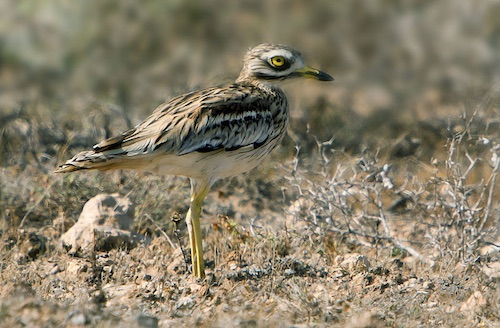LINKED PAPER
Multi-taxa consequences of management for an avian umbrella species . Robert W. Hawkes, Jennifer Smart, Andy Brown, Helen Jones, Steve Lane, Doreen Wells, Paul M. Dolman. 2019. Biological Conservation.
DOI: 10.1016/j.biocon.2019.05.039. VIEW
Birds are well-studied and popular compared to many other taxa. Whilst this provides an excellent basis for avian conservation, practitioners often lack information on less popular groups (e.g. invertebrates), which can result in a mis-match between current practice (e.g. for an avian flagship) and the management requirements of many other important species (Dolman et al. 2012). Focusing conservation towards single-species surrogates (e.g. umbrella species) can potentially address such discrepancies, but previous attempts to test this concept generally examine whether the abundance or occurrence of the umbrella coincides with many other species. This alone does not establish the wider biodiversity consequences of their management.
Whilst well-replicated multi-taxa experiments can provide this evidence, they are costly to carry out and monitor, and require large areas of land to implement. A low-cost alternative, which could be applied to any biogeographical region, is to consider existing knowledge of the autoecological requirements of the regional species pool, group species with similar requirements into ‘management guilds’, and predict the beneficiaries and disadvantaged arising from umbrella management (the Biodiversity Audit approach, see Dolman et al. 2012).
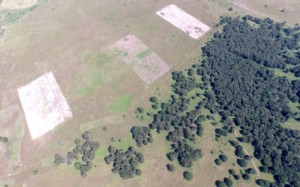
Figure 1 Three of the 66 2 ha experimental ground-disturbance plots implemented across the UKs largest grass-heath site (3,850 ha).
Here, we had a truly unique opportunity to implement a landscape-scale experiment to validate whether the Biodiversity Audit approach can successfully predict the beneficiaries of a UK threatened high-profile avian species, the Eurasian Stone-curlew Burhinus oedicnemus (hereafter ‘Stone-curlew’). We picked Stone-curlew because their flagship status has driven a 30-year conservation program dedicated towards the species, and a priori evidence (from Biodiversity Auditing) suggests that many nationally rare, scarce and threatened (hereafter ‘priority’) species should benefit from their management (Panter et al. 2013). Two ground disturbance treatments designed to benefit Stone-curlew were trialed across the UK’s largest grass-heath (Fig.1), with responses assessed for the abundance of five bird species of conservation concern, and the species richness (hereafter ‘richness’), overall abundance and relative composition of carabids, staphylinids, other beetles (non-carabid, non-staphylinid), true bugs and ants, sampling over 30,000 individuals of 400 species.
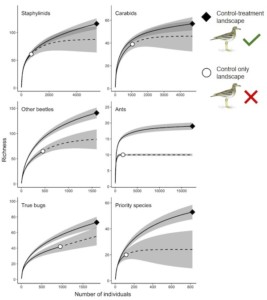
Figure 2 Extrapolated rarefaction curves and 95% CI limits for each of five invertebrate groups, and for all priority invertebrate species, for two hypothetical landscapes, one with Stone-curlew management (control-treatment landscape) and the other without (control only landscape). Symbols denote observed richness; solid and dashed lines interpolated and extrapolated richness respectively; shading represents 95% CI bounds. Sample-based rarefactions are rescaled to numbers of sampled individuals.
During the first year of management both treatments, unlike controls, provided suitable Stone-curlew nesting habitat, and encouragingly five of the treatment plots (but not controls) were colonized by breeding pairs during this first year. Treatments influenced the abundance of only one bird species (Northern Lapwing Vanellus vanellus; though Woodlark Lullula arborea increased in subsequent years, Hawkes et al. 2019); but carabid, other beetle and ant richness increased with one or both treatments, while staphylinid richness and abundance increased and true bug richness and abundance decreased with both treatments. Whilst this suggests there are both winners and losers from management, resampling and rarefaction showed hypothetical landscapes diversified by treatment (control-treatment landscape) supported a greater cumulative species richness of other beetles, ants and true bugs, and importantly priority invertebrates, than a landscape comprising only untreated controls (control only landscape) (Fig. 2). Finally, in agreement with our expectations, the richness of predicted beneficiaries (disturbed-grassland priority invertebrates) increased in response to both treatments, but interestingly the predicted disadvantaged (undisturbed-grassland species priority invertebrates) did not differ between treatments and controls (Fig. 3).
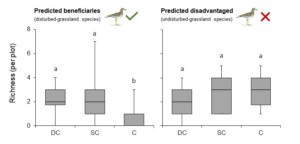
Figure 3 Observed cross-taxa richness of priority invertebrate species, shown separately for the predicted beneficiaries and disadvantaged of Stone-curlew management, across deep-cultivated (DC), shallow-cultivated (SC) and control (C) grass-heath plots. Means that share a superscript (homogenous sub-sets, a – b) do not differ significantly. Box plots show the median (central line), 25th and 75th percentiles (box) and range (whiskers).
We conclude that Stone-curlew represent a suitable management surrogate within this landscape and recommend strategies that promote heterogeneity by implementing ground-disturbance, but whilst also taking a precautionary approach to retain areas untreated (given uncertain responses of other, unsampled, taxa). Importantly this also demonstrates that systematic examination of the autoecological requirements of co-occurring taxa successfully predicted likely beneficiaries. Similar approaches, whether adopting experiments like ours or the Biodiversity Audit approach, would be particularly valuable in regions with high concentrations of priority species, especially where management interventions currently focus on a limited, unrepresentative and biased subset of species.
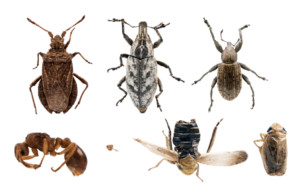
Figure 4 Some of the priority invertebrates identified through this study, and future years of the same experiment. Clockwise from the top-left; Arenocoris waltlii, Cleonis pigra, Hypera diversipunctata, Arocephalus languidus and Myrmica karavajevi © Annabelle Horton.
Next, we will investigate whether the immediate benefits observed by this study are retained with follow-up management (e.g. repeat disturbance to maintain open habitats), or whether retaining some plots fallow beyond their suitability for Stone-curlew offers different outcomes to broader biodiversity. We will also attempt to answer a question conservation practitioners often ask but empirical evidence is rarely available to answer – how much land needs to be managed to maximise biodiversity outcome.
Nominate this article for a BOU Science Communication Award.
References
Dolman, P.M., Panter, C.J., Mossman, H.L. 2012. The biodiversity audit approach challenges regional priorities and identifies a mismatch in conservation. J. Appl. Ecol. 49, 986-997.VIEW
Hawkes, R.W., Smart, J., Brown, A., Jones, H., Dolman, P.M. 2018. Experimental evidence that ground-disturbance benefits Woodlark Lullula arborea. IBIS 161, 447-452.VIEW
Panter, C.J., Mossman, H.L., Dolman, P.M. 2013. Stanford Training Area (STANTA) biodiversity audit to support grass heath management, University of East Anglia, Norwich.
Follow Rob on Twitter @Robert_W_Hawkes
Image credits
Featured image: Stone-curlew Burhinus oedicnemus | Juan Emilio | CC BY SA 2.0 | Flickr via Wikimedia Commons


